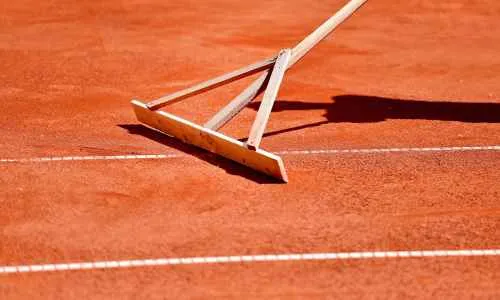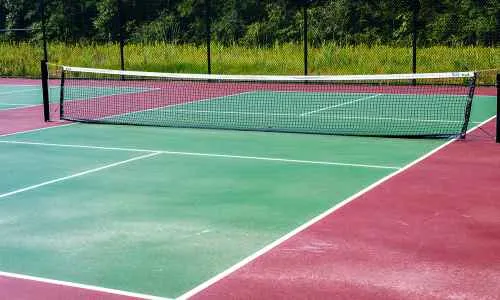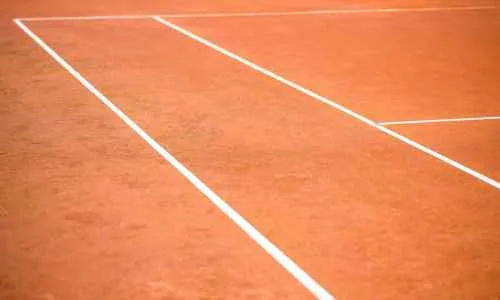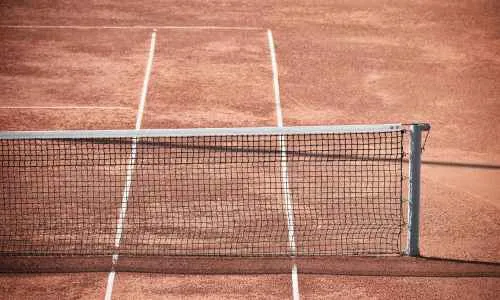Yes, you can confidently play pickleball on a clay court. Pickleball on a clay court offers a unique experience that combines the excitement of the sport with the benefits of a full-body workout. Playing pickleball on a clay court is a delightful experience combining tennis’s elegance with the agility of ping pong.
The soft and forgiving clay allows precise footwork and controlled shots, enhancing your game strategy. Dive into the exhilarating world of pickleball on clay, where you can rally, dink, and smash your way to victory while relishing the unique texture and feel of the court. Join us for a thrilling match and discover the joy of pickleball on a clay court like never before!
Table of Contents
pickleball on a clay court
A clay court is a pickleball court made of crushed stone, brick, shale, or other unbound mineral aggregate. The surface is most likely red, orange, green, or brown but looks and plays ultimately differently than the more common concrete or asphalt court. Clay courts are slower than other courts, such as hard and grass courts, and provide more grip for players. Players with technique on topspin and baseline rallies will find these rackets an excellent choice.

Clay Courts vs. Asphalt Courts
Clay courts and asphalt courts are two of the most common tennis courts. They have very different playing characteristics, which can affect your game in various ways.
pickleball on a clay court
Clay courts are made from a mixture of sand and crushed stone. This surface is slower than asphalt courts and provides more grip, making it easier to slide and change direction. Clay courts also produce higher ball bounces, making it more difficult to hit winners.
Pros of Clay Courts:
Joint-Friendly: Clay courts are easier on the joints, making them a preferred choice for players of all ages and physical conditions. The softer surface reduces the impact on the body during movements.
Predictable Ball Bounce: Clay courts provide a more predictable ball bounce than hard surfaces. This predictability allows players to anticipate and adjust to shots more effectively.
Extended Reaction Time: The slower pace of the ball on clay courts gives players more time to react to shots. This can lead to longer and more exciting rallies as players have a better chance to retrieve and return balls.
Rally Opportunities: Clay courts often lead to more extended rallies due to the slower ball bounce and added reaction time. This can result in a more strategic and engaging style of play.
Cons of Clay Courts:
Difficulty Hitting Winners: The slower surface of clay courts can make it challenging to hit winners, as shots may have a different pace and power than on hard courts. Players may need to rely more on placement and strategy to score points.
Reduced Agility: Sliding and changing direction quickly on clay courts is more complex than on hard surfaces. This may limit the effectiveness of certain agility-based maneuvers and shots.
Maintenance Requirements: Clay courts typically require more maintenance to keep the playing surface in optimal condition. This includes regular brushing and leveling to prevent unevenness and divots.
pickleball on Asphalt Courts
Asphalt courts are made from a mixture of asphalt and sand. This surface is faster and more rigid than clay courts, which can lead to more powerful shots and shorter rallies. Asphalt courts also produce lower ball bounces, which can make it easier to hit winners.
Pros of Asphalt Courts:
- It has a faster surface for hitting winners, allowing for more aggressive play and quicker point scoring.
- It makes sliding and changing direction easier, enhancing players’ agility and movement on the court.
- Requires less maintenance compared to clay courts, reducing upkeep demands.
Cons of Asphalt Courts:
- The more rigid surface can stress the joints more, potentially leading to discomfort or injuries, especially with prolonged play.
- Less predictable ball bounce, making it trickier for players to anticipate and adjust to shots.
- Less time to react to shots, resulting in shorter rallies and requiring players to make split-second decisions.
- Mastering the Explosive Pickleball Serve (Insane power + spin)
- How to prevent pickleball injuries
- World’s Highest Pickleball Court Returns to Dallas In July
- Adopting the Open Stance Pickleball Serve
- UPA-A launches professional paddle certification program
Clay pickleball and Asphalt Pickleball Court Dimensions the Same
Yes, the dimensions of a clay pickleball court are the same as those of an asphalt pickleball court. A standard pickleball court, including the lines, measures 20 feet wide by 44 feet long. The non-volley zone, also known as the seven-foot zone or the kitchen, is seven feet on either side of the net. The service line is seven feet from the net, and the baseline is 44 feet from the net.
Red Clay Courts vs. Har-Tru Courts: What’s the Difference?
Red clay courts and Har-Tru courts are both types of tennis courts that use a clay surface. There are, however, some significant differences between both of these.
Red clay courts are made from crushed brick or other types of clay. They are typically found in Europe and South America. Red clay courts are known for their slow speed and high bounce. It is, therefore, perfect for players who wish to prolong rallies and take advantage of spin.
Har-Tru courts are a type of green clay court that was developed in the United States. Har-Tru courts are made from crushed meta basalt, brick dust, and other materials. They are known for being more durable and easier to maintain than red clay courts. Har-Tru courts also have a slightly faster speed and lower bounce than red clay courts.

Red clay courts and Har-Tru courts are two popular types of clay courts used in pickleball, each with its characteristics and advantages. Here’s a comparison of the two:
1. Surface Material:
Red Clay Courts: Red clay courts, often called “European red clay,” are made from crushed brick or shale mixed with natural clay. The addition of iron oxide gives them their distinctive reddish color.
Har-Tru Courts: Har-Tru courts are made from crushed stone; specifically a greenish-gray stone called diabase, coated with a proprietary blend of crushed stone particles. This coating creates the court’s playing surface.
2. Playing Characteristics:
Red Clay Courts: Red clay courts are known for their slower pace than Har-Tru courts. They provide a high bounce, encouraging players to use topspin and rally from the baseline. The soft surface allows for sliding, adding a unique element to play.
Har-Tru Courts: Har-Tru courts offer a slightly faster pace than red clay. While they still slow down the ball compared to hard courts, they are quicker than red clay. The surface also promotes reasonable ball control and the ability to slide, although to a lesser extent than red clay.
3. Maintenance:
Red Clay Courts: Red clay courts require regular maintenance, including watering to prevent excessive drying and rolling to maintain an even surface. They can be more labor-intensive to maintain.
Har-Tru Courts: Har-Tru courts also need maintenance but require less water than red clay courts. Daily brushing or rolling is typically sufficient to keep the surface in good playing condition.
4. Color and Appearance:
Red Clay Courts: As the name suggests, red clay courts are reddish or orange, creating a visually distinct and traditional appearance.
Har-Tru Courts: Har-Tru courts have a greenish-gray color, which some players and clubs prefer for its aesthetics, as it can blend well with the surroundings.
5. Availability:
Red Clay Courts: Red clay courts are more commonly found in Europe and South America, where they are a staple for many professional and amateur tournaments.
Har-Tru Courts: Har-Tru courts are prevalent in the United States and are often used for pickleball clubs, both indoors and outdoors.
Your playing style and preferences determine which court is best for you. A red clay court is a fantastic choice if you enjoy playing long rallies and employ spin to your advantage. If you prefer a slightly faster court with a lower bounce, then a Har-Tru court is a good choice.
Here are some additional things to consider when choosing between a red clay court and a Har-Tru court:
Climate: Red clay courts are more susceptible to damage from rain and extreme temperatures. Har-Tru courts are more durable and can withstand a more comprehensive range of weather conditions.
Budget: Red clay courts are typically less expensive to build and maintain than Har-Tru courts.
Playing style: Red clay courts are ideal for players who want to extend rallies and use spin to their advantage. Har-Tru courts are a good choice for players who prefer a slightly faster court with a lower bounce.
Best Pickleball Ball For Clay Courts
Playing pickleball on clay requires careful ball selection. The ball will behave more inconsistently, particularly on short strokes. The Onix Pure 2 outdoor pickleball is the finest option for clay courts. It is more rigid and heavier than the Dura Fast.
Why do Pickleball Fans Like Clay Courts?
Players may enjoy playing pickleball on clay courts for several reasons:
Slower Pace: Clay courts, including those used for pickleball, offer a slower playing surface than hard courts. This slower pace can benefit players who prefer longer rallies and more controlled shots. It allows players to better strategize and react to their opponent’s moves.
Longer rallies: The slower bounce of clay courts allows for longer rallies, which can be more strategic and enjoyable for some players.
Easier on Joints: Clay is a softer surface than hard court or asphalt, which makes it easier on the joints. For injured athletes and older players in particular, this is helpful.
Enhanced Spin: Clay courts tend to grip the ball more, allowing players to generate additional spin on their shots. This increased spin can lead to greater shot control and the ability to add variety to their gameplay.
Slide Ability: Clay courts enable players to slide into their shots, similar to what is seen in tennis. This sliding ability can be a fun and helpful feature for players who want to cover the court quickly and execute well-placed shots.
Tactical Play: The slower nature of clay courts encourages tactical play. Players have more time to think about their shots and can use angles and placement to outmaneuver their opponents. This can make for a mentally engaging and strategic game.
Traditional Feel: Some players appreciate playing on clay courts’ classic and nostalgic feel. It harks back to the roots of tennis and pickleball, providing a sense of history and tradition.
Community and Social Aspect: Many pickleball players value the social aspect of the sport, and playing on clay courts at clubs or dedicated facilities can enhance the overall experience. It often leads to a sense of community and camaraderie among players.

Variety: For those who regularly play pickleball on hard courts or other surfaces, playing on clay courts can offer a refreshing change of pace and a new challenge. Variety in playing surfaces can help players develop a more well-rounded game.
Less expensive: Clay courts are also relatively inexpensive to build and maintain. This makes them a good option for communities and clubs looking to add pickleball courts.
Why Did Pickleball Move To Clay Courts?
The latest data about the increase in pickleball participation in the United States:
| Pickleball Statistics in the United States | Year | Change |
| Number of Players (APP) | Now | 36.5M |
| 3 Years Ago | +158.6% | |
| Annual Growth Rate (Overall) | 2021 | +11.5% |
| (Over the Previous 5 Years) | Per Year | +11.5% |
| USAPA Membership Increase | 2023 | +30% |
| Equipment Sales Increase (SFIA) | 2020-2021 | +21.3% |
According to these figures, pickleball’s appeal is still expanding quickly. People of all ages and skill levels enjoy playing this sport, practiced in local communities nationwide.
The ever-increasing number of pickleball players has yet to be accommodated by the current number of available hard courts. Clay tennis courts were adopted because even modified tennis courts were not meeting demand. Moving pickleball to clay courts made sense, as most tennis clubs have hard and clay surfaces.
Safety: Clay courts are easier on the body than hard courts, making them a good option for players of all ages and abilities. Clay courts are also less likely to cause slips and falls.
Performance: Clay courts provide a more controlled playing environment than hard courts. The ball bounces slower and with more spin on clay, which can make for longer rallies and more strategic play.
Variety: Playing pickleball on clay courts can offer players a new and challenging experience. Clay courts can also be used to host tournaments and events, which can help to grow the sport even further.
In addition to these reasons, some players also find that clay courts offer a more enjoyable playing experience. Clay courts are often located in more scenic settings than hard courts, and the red clay surface can be more visually appealing.
Pros and Cons of Playing Pickleball on Clay Courts
Following are the Pros of Playing Pickleball on Clay Courts:
- Slower Game: Clay courts lead to a slower bounce, encouraging longer rallies and strategic play, making it suitable for players of various skill levels.
- Joint-Friendly: The softer clay surface reduces joint stress, particularly for older or injured players.
- More excellent Surface: Clay courts offer a more excellent playing surface in hot climates, enhancing match comfort.
- Improved Grip: Clay courts provide better grip, reducing skidding and enhancing footwork.
- Added Challenge: Clay courts introduce an extra layer of challenge, making the game more rewarding for experienced players.
Following are the Cons of Playing Pickleball on Clay Courts:
- Inconsistent Bounce: The bounce on clay courts can be unpredictable due to weather conditions, surface conditions, and ball types.
- Maintenance: Clay courts require regular, labor-intensive maintenance, including rolling and watering, to maintain optimal playing conditions.
- Slippery When Wet: Clay courts can become slippery when wet, potentially posing a safety hazard.
- Limited Availability: Compared to hard courts, clay courts for pickleball are less widely available, potentially limiting player access.
Clay courts can be an excellent option for pickleball players of all skill levels. They offer many benefits, such as a slower game, more grip, and a cooler surface temperature. However, players should be aware of the potential drawbacks, such as high maintenance and inconsistent bounce.
How Can Pickleball be Played on Clay?
Playing pickleball on clay courts does require some adjustments and precautions to ensure a safe and enjoyable experience. Here are some additional tips to consider:
Choose the Right Footwear: Proper footwear is crucial when playing on clay courts. Opt for tennis or court shoes with non-marking soles that provide good traction. Avoid running or cross-training shoes, which may not grip the clay surface effectively.
Mind the Lines: On clay courts, the lines are often made of a different material and can be more slippery than the central playing surface. Be mindful of these lines when moving around the court to prevent slipping.
Stay Hydrated: Playing pickleball can be physically demanding, even on clay courts. Ensure you stay hydrated by bringing a water bottle and taking regular water breaks, especially on hot days.
Adapt Your Strategy: Besides using more topspin, consider changing your positioning on the court. Being closer to the net can help you control points better, as the slower clay surface may make retrieving shots from the backcourt more challenging.
Practice Your Volleys: Since the slower bounce on clay courts can make it harder to hit winners from the baseline, work on your volleying skills. Being proficient at the net can give you an advantage.

Watch Your Footing: Clay courts can become uneven due to wear and tear. Pay attention to any irregularities or divots in the court to avoid tripping or injuring yourself.
Respect Court Maintenance: If you’re playing on a clay court at a club or facility, consider the maintenance requirements. Brush the court surface regularly to keep it in good condition and pick up any litter or debris.
Play Safe: As with any surface, be aware of your surroundings and fellow players. Avoid running into the net or colliding with your opponents.
Enjoy the Experience: Playing pickleball on clay can be a unique and enjoyable experience. Embrace the differences in the game and relish the challenge it presents.
Remember that adapting to different court surfaces is part of the fun and versatility of pickleball. With the right equipment and adjustments to your game, you can have a rewarding time playing on clay courts while staying safe and having fun.
Suitable Playing Surfaces for Pickleball
Pickleball can be played on various playing surfaces, such as:
Hard courts: Hard courts are the most common type of surface used for pickleball. They can be made of concrete, asphalt, or acrylic. Hard courts offer a consistent bounce and are relatively easy to maintain.
Clay courts: Clay courts are also famous for pickleball. They offer a slower pace of play and a more predictable bounce than hard courts. However, clay courts require more maintenance and can be slippery when wet.
Grass courts: Grass courts are less common for pickleball but can be used. Grass courts offer a softer surface and a more unpredictable bounce than hard or clay courts.
Indoor courts: Pickleball can also be played on indoor courts. Indoor courts are typically made of wood, rubber, or synthetic materials. Indoor courts offer a more consistent playing surface than outdoor courts, and they are less affected by weather conditions.
Conclusion
Playing pickleball on clay courts offers a distinctive and enjoyable experience for those who appreciate the unique characteristics of this surface. The slower pace, increased spin, and softer impact on joints make it an attractive option for players looking to change from traditional hard courts. The ability to slide into shots adds an exciting element to the game.

